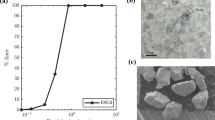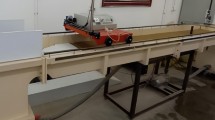Abstract
Backwater rise is a function of flow properties, fluid characteristics, and channel geometries. Flume experiments were conducted to investigate the effect of the permeable spur dike dimensions (blockage ratios of 45% to 77%) and diameters of mono-size glass beads (7.4 mm to 26.0 mm) on the backwater rise in open channel subcritical flow. Dimensional analysis was performed to correlate different variables affecting the flow hydraulics. Flow rates of 15 and 30 m3/h were used with each spur dike size and diameter. Results show a linear relationship between the Froude number and backwater rise downstream the spur dike. High upstream water levels were observed as the blockage ratio decreased. A coefficient shape of 0.48 was suggested for permeable rectangular spur dikes using Yarnell’s equation for backwater rise with no statistical analysis differences between the measured and predicted data. Dimensional analysis was applied to predict the upstream (u/s) water levels for all models, exhibiting an excellent agreement between the measured and predicted water levels, with R2 of 0.98.









Similar content being viewed by others
References
Dey S, Barbhuiya AK (2005) Flow field at a vertical-wall Abutment. J Hydraul Eng ASCE 131(12):1126–1135. https://doi.org/10.1061/(ASCE)0733-9429(2005)131:12(1126)
Al-Husseini TR, Al-Madhhachi AT, Naser ZA (2020) Laboratory experiments and numerical model of local scour around submerged sharp crested weir. J King Saud Univ Eng Sci 32:167–176. https://doi.org/10.1016/j.jksues.2019.01.001
Al-Husseini TR, Hamad HT, Al-Madhhachi AT (2021) Effects of an upstream sluice gate and holes in pooled step cascade weirs on energy dissipation. Int J Civ Eng 19:103–114. https://doi.org/10.1007/s40999-020-00568-7
Muhsun SS, Al-Madhhachi AT, Al-Sharify ZT (2020) Prediction and CFD Simulation of the flow over a curved crump weir under different longitudinal slopes. Int J Civil Eng 18(9):1067–1076. https://doi.org/10.1007/s40999-020-00527-2
Azinfar H, Kells JA (2008) Backwater prediction due to the blockage caused by a single, submerged spur dike in an open channel. J Hydraul Eng ASCE 134(8):1153–1157. https://doi.org/10.1061/(ASCE)0733-9429(2008)134:8(1153)
Azinfar H, Kells JA (2011) Drag force and associated backwater effect due to an open channel spur dike field. J Hydraul Res 49(2):248–256. https://doi.org/10.1080/00221686.2011.552470
Yazdi J, Sarkardeh H, Azamathulla H, Ghani AA (2010) 3D simulation of flow around a single spur dike with free-surface flow. Intl J River Basin Manag 8(1):55–62. https://doi.org/10.1080/15715121003715107
Mohamed YA, Abdel-Aal M, Nasr-Allah TH, Shawky AA (2016) Experimental and theoretical investigations of scour at bridge abutment. J King Saud Univ Eng Sci 28(1):32–40. https://doi.org/10.1016/j.jksues.2013.09.005
Duan JG (2009) Mean flow and turbulence around a laboratory spur dike. J Hydraul Eng ASCE 135(10):803–811. https://doi.org/10.1061/(ASCE)HY.1943-7900.0000077
Kara S, Stoesser T, Sturm TW, Mulahasan S (2015) Flow dynamics through a submerged bridge opening with overtopping. J Hydraul Res 53(2):186–195. https://doi.org/10.1080/00221686.2014.967821
Al-Hashimi SA, Al-Osmy SA, Mulahasan S (2020) Water surface profile and flow pattern simulation over bridge deck slab. J Eng Sci Technol 15(1):291–304
Kang J, Yeo H, Kim S (2011) Permeability effects of single groin on flow characteristics. J Hydraul Res 49(6):728–735. https://doi.org/10.1080/00221686.2011.614520
Koken M, Gogus M (2015) Effect of spur dike length on the horseshoe vortex system and the bed shear stress distribution. J Hydraul Res 53(2):196–206. https://doi.org/10.1080/00221686.2014.967819
Uijttewaal WS (2005) Effects of Groyne Layout on the flow in groyne fields: Laboratory experiments. J Hydraul Eng ASCE 131(9):782–791. https://doi.org/10.1061/(ASCE)0733-9429(2005)131:9(782)
Kang J, Yeo H, Kim S (2012) Experimental study on the flow characteristics around the refraction groyne. Engineering 3:842–850. https://doi.org/10.4236/eng.2011.38103
Alireza M, Hamed O, Ali LM, Hamid H (2016) Numerical investigation of flow around groins in barotropic condition. Int J Struct Civil Eng Res 5(4):285–291
Jiyonga L, Yeongkyub K, Jun-Hoc C, Kang S (2019) Measurements of turbulent flows downstream of a spur dike at different Froude numbers. J Korea Water Resour Assoc 52(2):115–123. https://doi.org/10.3741/JKWRA.2019.52.2.115
Zhang X, Pingyi Z, Chengyu Y (2012) Experimental study on flow turbulence distribution around a spur dike with different structure. Int Conf Modern Hydraul Eng Procedia Eng 28:72–775
Thompson DM, Carrick CR (2010) A flume experiment on the effect of constriction shape on the formation of forced pools. Hydrol Earth Syst Sci Discuss 7:1945–1972. https://doi.org/10.5194/hess-14-1321-2010
Rajaratnam N, Nwachukwu BA (1983) Erosion near groyne-like structures. J Hydraul Res 4:277–287. https://doi.org/10.1080/00221688309499434
Yeo HK, Kang JG, Kim SJ (2005) An experimental study on tip velocity and downstream recirculation zone of single groynes of permeability change. KSCE J Civ Eng 9(1):29–38. https://doi.org/10.1007/BF02829094
Ettema R, Muste M (2004) Scale effects in flume experiments on flow around a spur dike in flatbed channel. J Hydraul Eng ASCE 130(7):635–646. https://doi.org/10.1061/(ASCE)0733-9429(2004)130:7(635)
Shahjahan A, Hasan M, Haque M (2017) Two-dimensional simulation of flows in an open channel with groin-like structures by iRIC Nays2DH. Math Probl Eng 2017:1275498. https://doi.org/10.1155/2017/1275498.
Ho J, Yeo HK, Coonrod J, Ahn WS (2007) Numerical modeling study for flow pattern changes induced by single groyne, 32nd congress of IAHR, Venice, Italy
Baba Y, Camenen B, Peltier P, Thollet F, Zhang H (2010) Flows and bedload dynamics around spur dyke in a compound channel. In: The 11th international symposium on river sedimentation (ISRS), Stellenbosch, South Africa, p 11. hal-00545965
Zhou Y, Qian S, Sun N (2014) Application of permeable spur dike in mountain river training. Appl Mech Mater 642:236–240.https://doi.org/10.4028/www.scientific.net/AMM.641-642.236
Tambe RK, Kulkarni D (2017) Studies of effect of length of the permeable spur on various hydraulic parameters. Int J Innov Res Sci Eng Technol 6(2):3046–3064
Marak DR, Saikia MD (2018) Comparisons of velocity distributions due to permeable and impermeable spur-dike in a rectangular channel. Int Res J Eng Technol (IRJET) 5(5):3610–3613
Kaatz KJ, James WP (1997) Analysis of alternatives for computing backwater at bridges. J Hydraul Eng ASCE 123(9):784–792. https://doi.org/10.1061/(ASCE)0733-9429(1997)123:9(784)
Hunt J, Brunner GE, Larock BE (1999) Flow transition in bridge backwater analysis. J Hydraul Eng ASCE 125(9):981–983. https://doi.org/10.1061/(ASCE)0733-9429(1999)125:9(981)
Oak AG (1992) Backwater rise due to a submerged spur. M.Sc. thesis, Department of Civil Engineering, University of Saskatchewan, Saskatoon, Sask
Brauer EJ (2013) The effect of dikes on water surfaces in a mobile bed. Thesis, University of Illinois
Yang J, Zhang J, Zhang Q, Teng X, Chen W, Li X (2019) Experimental research on the maximum backwater height in front of a permeable spur dike in the bend of a spillway chute. J Water Supply 19(6):1841–1850. https://doi.org/10.2166/ws.2019.061
Shen S, Li Y, Li H, Guo Z, Zhou Z, Mao L (2019) Numerical simulation on optimization scheme of permeable hole of permeable sheet piling spur dike. In: International conference on civil and hydraulic engineering IOP conference series: earth and environmental science, vol 304, pp 052074. https://doi.org/10.1088/1755-1315/304/5/052074
Yarnell DL (1934) Bridge piers as channel obstructions. U. S. Department of Agriculture, Technical Bulletin, pp 442–451
Acknowledgements
The authors acknowledge the staff and faculty of Hydraulic and Hydrology Laboratory, Mustansiriyah University (www.uomustansiriyah.edu.iq), for their valuable help in fixing and sustaining the apparatus utilized in this research paper. All equipment and materials used in this study were provided by the authors themselves and Mustansiriyah University.
Author information
Authors and Affiliations
Corresponding author
Ethics declarations
Conflict of interest
The corresponding author states that there is no conflict of interest.
Rights and permissions
About this article
Cite this article
Mulahasan, S., Al-Mohammed, F.M. & Al-Madhhachi, AS.T. Effect of blockage ratio on flow characteristics in obstructed open channels. Innov. Infrastruct. Solut. 6, 211 (2021). https://doi.org/10.1007/s41062-021-00592-z
Received:
Accepted:
Published:
DOI: https://doi.org/10.1007/s41062-021-00592-z




